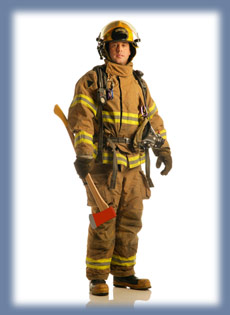FIRE FIGHTING/RESCUE COURSES:
Auto Extrication:
Designed For: All fire service personnel
Description: Provides hands-on experience in the procedures and systems utilized
during an automobile extrication. Subjects covered include: Auto extrication,
types of hand and power tools, removing windows, opening doors, removing
roofs, pulling steering wheels, moving foot pedals, raising dashboards, pulling
seats, stabilization of vehicles, and simulated rescues of trapped victims.
Prerequisites: None
Certification: None
Hours: 16
Class Size: 40
Student/Instructor: Ratio 10:1 (for skills proficiency)
Restrictions: This course requires a site with adequate materials and equipment
to deliver the training according to the course outline.
Command and Control of the RIC Deployment:
Designed For: Fire officers who may be Incident Commanders at a fire fighter emergency
Description: This command level awareness course provides students with the terminology and
methodology that is employed during a RIC deployment. Classroom simulations based on case
studies allow students to participate in simulated RIC deployments. Students who wish
to progress to the operational level may initiate a task book for additional experience.
Prerequisites: I-200, Fire Command 1A, and successful completion of precourse work RIC Tactics
or RIC Operations is recommended
Certification: None
Hours: 8
Class Size: 20
Confined Space Rescue Awareness:
Designed For: All fire service personnel
Description: This course provides instruction in identifying a permit and nonpermit required
confined space, the hazards associated with confined spaces, target industries and hazards,
state regulations, communications, and equipment requirements. This course does not qualify
participants to make permit required entries.
Prerequisites: None
Certification: None
Hours: 7
Class Size: 40
Restrictions: None
Fire Fighter Survival:
Designed For: All fire service personnel
Description: This course was developed in the continuing effort to reduce the number of fire
fighter injuries and fatalities that occur on an annual basis and provides a greater
understanding how to avoid committing fatal errors on the fireground. Avoiding situations
that could cause you to become lost, trapped, or injured is the best way to prevent tragedies
at a fire scene. Topics include fire fighter survival terminology, developing a survival
attitude, increasing situational awareness, and being trained in problem-solving techniques
so you can become more self-reliant in an emergency. Case studies will be reviewed to outline
factors common in many line-of-duty deaths (LODDs) across the nation.
Prerequisites: None
Certification: None
Hours: 16
Class Size: Student/Instructor ratio is 10:1 (40 students maximum with four Primary Instructors)
Restrictions: This course requires a site with adequate materials and equipment to deliver the
training according to the course outline.
Low Angle Rope Rescue Operational:
Designed For: All fire service personnel
Description: Designed to equip the student with the techniques and methods for using rope, webbing,
hardware friction devices, litters in low angle rescue situations. Areas covered include rope and
related equipment, anchor systems, safety lines, stretcher lashing and rigging, mechanical
advantage systems, and single-line and two-line rescue systems.
Prerequisites: None
Certification: None
Hours: 24
Class Size: Student/Instructor ratio is 12:1 (48 students maximum with four Primary Instructors)
Restrictions: This course requires a site with adequate materials and equipment to deliver the
training according to the course outline.
RIC Operations:
Designed For: All fire service personnel
Description: The Rapid Intervention Crew Operations course trains fire fighters to rescue a
downed fire fighter in an immediately dangerous to life and health environment in the
continuing effort to reduce the number of fire fighter injuries and deaths that occur
regularly. Students train using evolutions and scenarios based off tragedies suffered by
fellow fire fighters from departments across the country. Students receive information on
how to locate and use these LODD studies as training and prevention tools throughout their
careers. The course focuses on the three phases of a RIC operation: 1) predeployment,
2) deployment, and 3) Rescue. During the class, you will also gain a greater understanding
of RIC operations terminology and the RIC mindset.
Prerequisites: Fire Fighter I training, Fire Fighter Survival
Certification: None
Hours: 24
Class Size: Student/Instructor ratio is 10:1 (40 students maximum with four Primary Instructors)
Restrictions: This course requires a site with adequate materials and equipment to deliver the
training according to the course outline.
River and Flood Water Rescue:
Designed For: All fire service personnel
Description: This course is intended for the training of fire service personnel in water rescue
techniques. Topics include swift water rescue, submerged vehicles, drowning, use of engine/truck
company equipment for water rescue, use of rafts and boats, and underwater search and recovery.
Prerequisites: None
Certification: None
Hours: 16
Class Size: 40
Student/Instructor: Ratio: 10:1 (Skills Proficiency)
Restrictions: This course requires a site with adequate materials and equipment to deliver the
training according to the course outline.
Trench Rescue:
Designed For: All fire service personnel
Description: This course is designed to train fire service personnel in hands-on application
of the techniques necessary to safely affect a rescue from an excavation or trenching cave-in.
Topics include: Critical considerations while responding to trenching emergencies, evaluation
of cave-in scenes, basic life support procedures and temporary protection for victims,
specialized tool usage, shoring techniques, and below grade rescue safety procedures.
Prerequisites: None
Certification: None
Class Size: 40
Student/Instructor: Ratio: 10:1 (Skills Proficiency)
Restrictions: This course requires a site with adequate materials and equipment to deliver
the training according to the course outline.
Forcible Entry Operations
Designed For: All fire service personnel
Description: With today’s technology of construction and materials, heavily fortified doors
often require an extensive forcible entry operation to gain entry. No matter what part of the
county you live in, crime is moving into our neighborhoods and residents and business owner
are taking action by fortifying their homes and businesses. These security-conscious residents
and business owners secure their properties using methods that many firefighters and fire
departments are not familiar with, requiring new tools and techniques to breach safely and
quickly. Click here to learn more.
Prerequisites: Fire Fighter I Training Recommended
Certification: None
Back to top

